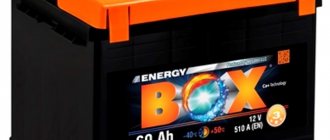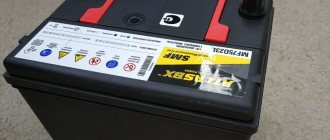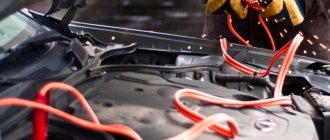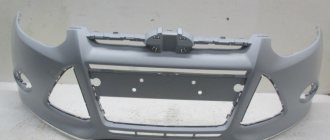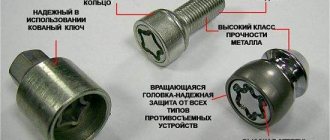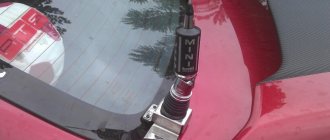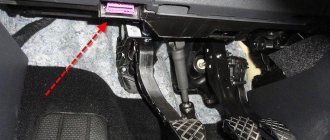When removing the battery from a car, what is the order in which the terminals are removed?
Which terminal should you put on the battery first when installing it?
Should the plus or minus wire be put on and removed first from the battery?
The reason for this strong opinion among car enthusiasts is which terminal should be removed/installed first, solely to prevent the harmful consequences of careless installation/disassembly.
To begin with, an educational program on the topic “what is what” so that by following our advice you can distinguish one from the other. Any rechargeable battery has banks connected in series, which are connected to two outer contacts - the “+” terminal is usually indicated in red or orange and has a thicker truncated cone, and the “-” terminal is indicated in blue or black and has a slightly thinner cone. The downside is “ground” - the contact is constantly closed to the car body. Plus it always breaks with the keys of the electrical circuit.
Battery installation (installation)
When installing the battery, the “+” terminal is put on first; the “-” terminal is put on last. And the point here is not even in the recommendations of the manufacturers, but in eliminating possible accidental short circuits with a metal object to the “+” terminal and parts of the car body. If this happens when the “-” terminal is not yet connected, there will be no short circuit. But when you installed the minus terminal first and began to install the plus, when tightening the latter, it’s not surprising to break the wrench on the body.
Dismantling the battery (removal)
If you are removing a battery, the first step is to loosen and remove the wire from the negative terminal. Because the “minus” is already connected to the car body and is “ground.” If you short-circuit the minus key to the body, nothing will happen (there is no short circuit between the same potential). After you have removed the first minus, you have removed the minus and from the car body, now you can unscrew the positive terminal, and even if you touch the plus and parts of the body, there will be no short circuit either, because the body no longer has a second contact.
No matter how careful you are, I would advise you to remember this rule, because there are situations when you have to install the battery in very cramped conditions, in poor lighting, and even in the dark to the touch. This is where it will come in handy for you. The last one is always “minus”, either during removal or during installation - accordingly, the removal began with a minus and the installation ended with a minus.
When it comes to how to remove the battery from a car, those drivers who are going to do this for the first time have a question about which terminal to remove first from the battery. There may be several reasons for removing the battery from the car: charging, the need to replace the old battery with a new one. In any case, beginners in this matter are interested in the sequence of actions, what needs to be done first and what needs to be done later.
Removing a car battery is not difficult, and most operating instructions will tell you how to remove the battery correctly. As elsewhere, in order to do everything correctly and avoid serious mistakes, it is customary to follow certain safety precautions.
Read also: Real SUVs with locking
Safety precautions when removing the battery from a car
It is not allowed to apply large forces to the battery during its removal. If something is “jammed”, it is better to carefully examine the battery and the space surrounding it: it is quite possible that it will not be physical strength that will be required, but a certain skill and skill.
If the batteries are not seriously damaged, they can be easily removed: use a regular adjustable wrench and a rag. Of course, you need to handle the battery very carefully: do not push, do not throw, and carefully place the removed battery on a flat, safe place to avoid it overturning.
Don't forget, just in case, to prepare an alkaline deactivator in case the liquid electrolyte spills and the acid gets on your skin. With the utmost care, this should not happen, but it never hurts to be on the safe side.
Procedure for removing the battery from the car
So, removing the battery from the car is carried out in a certain order:
- Turn off the ignition .
- Turn off all electronics in the car that operate without the ignition.
- Close all windows and doors in the car .
- Unscrew the cover that prevents dust and dirt from accumulating on the battery terminals .
- Disconnect the grounding if the machine was previously grounded.
- There are batteries with or without a protective cover. If there is no protective cover, in order to avoid a short circuit, insulate the “plus” with technical tape or use an ordinary plastic cap - this will protect the further process of removing the terminals;
- Carefully loosen the ground nut with a wrench .
- Now disconnect the terminals . The main question is which terminal to remove from the battery first? There is a strict rule: first remove the negative terminal, and only then remove the positive terminal .
- Do not allow the positive pole to come into contact with metal parts of the machine. .
An important technical point: it is the negative pole that needs to be disconnected first because this prevents a short circuit from occurring due to the fact that the mass remains without potential.
The mass is nothing more than the car body, which is connected to the negative terminal of the battery. When this terminal is removed, the battery is first disconnected from the body. The electrical circuit running from the negative potential of the battery to the car body is temporarily broken, and a short circuit will no longer occur. As you can see, removing the terminals from the battery is not difficult - the main thing is not to overdo it with force. And when removing, be extremely careful not to confuse the polarity and prevent a short circuit in the electrical circuit, which could be fatal.
Next, you should carry out the necessary actions (either replacing the old battery with a new one, or charging it), and then proceed to install the battery back. Immediately before this, clean the terminals with soda and a stiff brush, and if there are any deposits on them, remove them with distilled water. Do not use ordinary water to avoid the formation of salts.
Leakage currents
The fact is that the car network is a closed system, and there is always voltage in it, which, although not felt, can discharge the battery over time. Devices such as an electronic control unit, car radio, beacons and on-board computer can consume energy even when not in use.
Another question is how long does this take and is it worth disconnecting the terminal every night? If we consider the opinions of motorists, it becomes clear what exactly influences the decision.
A specific model, its features and the reliability of the electrical network
For example, in VAZs, the battery can become quite low even overnight, and network faults in the form of a lack of fuses (with homemade “improvements” of various systems) sometimes cause a short circuit.
Personal experience of a vehicle owner
This is definitely done by those whose driving experience dates back to Soviet times. And those who rightly believe that any battery runs out over time. It is also worth considering the so-called self-discharge of the battery, which occurs even when the terminal is removed, aggravating the discharge process. Regularly disconnecting the terminal slows it down.
Putting the battery back into the car
When installing the battery back into the car, you must also follow a certain connection procedure.
Remember that the battery must be connected to the car in reverse order:
- return the battery to its original place ;
- attach it with a standard mount ;
- Now the clamps are connected in the reverse order - first connect the terminal with the plus sign to its “native” contact ;
- tighten the nut tightly with an adjustable wrench ;
- and only after that the same should be done with the negative terminal .
Restoring vehicle on-board settings
In addition, it is necessary to ensure that all the “on-board electronics” of the machine, with the help of which the monitoring and control of its service systems are carried out, do not go astray and do not have to be restored again. When the battery is disconnected, all parameters are reset automatically.
Read also: Is it possible to drive without a state license plate?
The experience of motorists, developed while communicating with modern cars, abundantly stuffed with various types of electronics, helped to create the following algorithm of actions:
- start the engine , bring it to the usual temperature;
- turn off the engine ;
- remove the terminal with the minus sign , wait three minutes;
- put it back ;
- do the same with the positive terminal ;
- start the engine again, let it run for 15 minutes - during this time the computer system will restore all the basic data;
- turn off the ignition - after turning it off, all information will be saved;
- start the engine again and test it in all possible modes;
- Turn off the ignition again and wait until the system records all parameters.
Now all the basic settings that were connected earlier work fine. This algorithm of action for restoring basic data on a car’s on-board system is recommended by drivers regardless of what brand of car is used. To check, you can try it on any machine and evaluate how effective it really is. The main thing is not to forget about the rules of polarity and the procedure for working with terminals.
When interacting with a battery, the main thing is not to forget how to properly remove the terminals and in what order to install them back. With a correctly removed and also correctly connected battery, no unexpected damage in the form of a short circuit will occur. And if you manage to master the independent restoration of the electronic support system, you can consider that you have mastered the full control of a modern car.
There is not a single car owner who does not have to remove the battery from his car at least once. However, not everyone knows how to properly remove and install the battery. And first of all - which terminal to remove first and which one to put on.
Results
Timely battery care will help prevent possible problems and damage. Therefore, before leaving the car for a long time, it is worth asking about the rules of such parking and the question of how to avoid discharge and in what sequence to remove the terminals from the battery. You can go for an experiment and imagine yourself as Kulibin, regardless of safety precautions, manuals and advice from mechanics, but it’s better not to tempt fate.
Which terminal do you remove first?
Which terminal to remove first?
To understand which terminal needs to be removed first, you need to remember your school physics course. The “ground” is connected to the negative terminal of the battery, which is the metal elements of the car - the body, frame, engine, etc. All energy consumers in the car are connected to the positive terminal - the starter, lighting, headlights, audio system, etc.
When any terminal is removed, the circuit opens, so formally the order of removal is not important. However, if the removal procedure is incorrect, there is a risk of a short circuit. In this case, not only the elements of the car can be damaged, but also the person performing the manipulation.
If you remove the positive terminal first, and then accidentally touch the positive contact of the battery and the metal part of the car (ground) with a metal object, for example a wrench, then a strong short circuit will occur. If you remove the negative terminal first, the mass will be de-energized, so further removal of the “plus” will not lead to a short circuit even with careless actions.
Therefore, the sequence of actions when removing the battery is as follows.
- First, the standard battery mount is unscrewed.
- The nut securing the negative contact is loosened.
- The negative terminal is removed.
- Then the nut securing the positive contact is loosened.
- The negative terminal is removed.
- The battery is removed from the stand.
Which one to wear first?
When installing the battery and putting on the terminals, you must do the opposite, that is, proceed in the reverse order of removal.
- First you need to install the battery on the stand.
- Put on the positive terminal, screwing it to the contact using a nut and an open-end wrench.
- Then you need to put on the negative terminal, connecting the ground to the electrical circuit.
- Tighten the nut securing the negative terminal.
Read also: Is the new Lada Granta galvanized or not?
If you are going to remove it completely: how to remove it
Some drivers prefer to prevent their car's battery from draining by removing it completely, for example when the car sits in a cold garage all winter. This is required for a completely dead battery, which cannot be charged using wires. In this case, the battery is taken home for the night and connected to electricity.
Once you have dealt with the terminals and completely de-energized the car, you can begin to disconnect the battery holders. The fasteners can go through the entire battery or under it.
We remove the battery from the car to charge it at home
Then you need to carefully remove it without spilling the electrolyte. Only an alkaline deactivator will help remove acid from the skin. This will complete the process. As you can see, there is nothing complicated about it.
Is it possible to disconnect one terminal when storing the battery?
When parking the car for a long time, which does not involve completely removing the battery, it is recommended to disconnect both terminals of the battery. If you leave them in the electrical circuit, the battery will discharge due to operating energy consumers (alarms, individual sensors, radars, etc.). It is not recommended to remove only one terminal due to the following reasons.
- If you leave the negative terminal connected, leakage currents will remain in the electrical network, and the battery will discharge faster.
- If you leave the positive terminal connected, a short circuit may occur, which can result in damage to wiring and devices and even fire in the car.
Removing the terminal to reset the error
Removing the battery terminal is a common method of dealing with errors that are diagnosed by the car's on-board computer. A lit Check Engine light irritates many car owners, so they often resort to this simple method of troubleshooting.
As a result, all data on errors and sensor readings accumulated since the last time the battery was removed is erased from the computer's memory. It is worth noting that serious errors associated with malfunctions cannot be eliminated in this way. After you start using the car, they will appear again. So, it only makes sense to remove the terminals to reset errors in cases related to low-quality fuel, ignition failure, etc.
To reset the error, just disconnect the negative terminal and wait for a while - from 3 to 10 minutes. Then you can connect it back. If both terminals were removed, then you need to start from the plus.
When the error is reset, all vehicle settings return to factory settings. This means that the ECU now needs to be retrained, especially if the car is equipped with an automatic transmission.
Training is carried out using the following method.
- After the specified time has passed, you need to connect the terminal to the battery.
- Then you need to turn the ignition key to the last position before starting the starter and wait a minute, then return the key to its original position.
- Start the engine and leave it idling for at least 5 minutes without accelerating. Additional equipment such as a stove, air conditioning, headlights, and radio must be turned off.
- Stop the engine and turn the ignition key to the extreme left position.
- Then you should repeat the procedure 1-2 more times.
When training a car with an automatic transmission, you additionally need to train the adaptive gearbox.
- When starting the engine, you must hold the selector knob in the neutral position (N) for at least 1 minute.
- Move the lever to position D and hold it for at least 1 minute, securing the car using the parking brake.
- Release the brake and start moving smoothly without adding gas. It is necessary that the box switches all gears corresponding to a smooth increase in speed up to 60-70 km/h.
- Then you need to gradually reduce the speed to learn how to change gears back.
If you follow all safety precautions, then there is no fundamental order in removing and putting on the terminals on the battery. However, the correct course of action will help prevent emergency situations that can not only lead to damage to car parts, but also pose a danger to the life and health of the car owner.
Resetting the brains of VAZ
In order to “reset the brain” or reboot the computer of the VAZ car, press the daily mileage reset button, without releasing it, turn the key to start. The instrument combination goes into self-test mode. There is a threefold deviation of all needles (tachometer, speedometer, engine temp., fuel). If at this time you press the engine daily mileage button again on the mileage panel, the firmware version will appear, if you press it again it will show errors. If there are no errors, it shows ZERO. If there are errors, remember them, press the daily mileage key for 2-3 seconds and reset the error (ZERO appears).
Resetting the computer after removing the battery on a VAZ
When the battery is removed, the computer is reset and current data on the operation of the sensors is erased. This is where the main problem lies. Since when installing the battery back, the basic conditions for the normal further functioning of the car are not met. To do this, it is necessary to correctly connect the new battery so that the engine will subsequently delight you with its operation and not cause trouble.
- Warm up the engine to operating temperature, preferably while driving.
- We remove the NEGATIVE terminal from the battery for 3 minutes, the computer memory is “zeroed”.
- Reinstall the terminal. If the battery was completely removed, first connect the POSITIVE terminal
- WITHOUT touching the gas pedal, we start the engine.
- We warm up for 10-15 minutes, information is collected from the sensors of the on-board systems.
- Turn off the ignition to record data into the computer memory.
- We start the engine and accelerate to 50-60 km/h, followed by a complete stop.
- Turn off the ignition to record data from speed sensors, gearboxes, etc. into the computer memory. working while moving.
